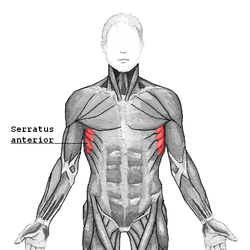Serratus anterior muscle
| Serratus anterior muscle |
|---|

|
| Serratus anterior muscle of man |
| origin |
| Upper nine ribs |
| approach |
| Margo medialis and angulus inferior and superior of the scapula |
| function |
tilts the shoulder blade:
|
| Innervation |
| Thoracic nerve longus |
| Spinal segments |
| C5-C7 |
The serratus anterior muscle ( Latin for "front saw muscle" or "front saw tooth muscle"; outdated: muscle serratus lateralis , Jenaer Nomina Anatomica 1935) is a skeletal muscle of the shoulder girdle . It runs from the chest towards the back and forms a characteristic pattern that looks like a row of saw teeth; therefore the name. Another name is boxer muscle.
The upper part of the serratus anterior muscle is covered by the pectoral muscle and is not visible on the body surface. It can be divided into three parts: the upper part ( pars superior ) originates from the first and second rib, the middle part ( pars divergens or pars intermedia ) from the second to third and the lowest part ( pars convergens or pars inferior ) the fourth through the ninth rib. The blood supply is provided by the superior thoracic artery and the lateral thoracic artery .
The subscapularis muscle is pressed into the pars divergens of the muscle, the pars convergens is mostly visible through the skin.
function
The sawtooth anterior muscle can move and tilt the shoulder blade , pulling it toward and away from the body. This is important to allow the arm to move upwards, beyond the horizontal, and backwards, onto the back. When the arms are propped up and the shoulder blades are fixed , the muscle serves as an inhalation muscle , as it lifts the ribs.
The serratus anterior muscle enables the shoulder blade to be pulled forward and around the chest.
The muscle is an antagonist of the rhomboid muscles ( musculus rhomboideus major and minor ). However, when the upper and lower parts work together, they press the shoulder blade against the rib cage along with the rhombus muscles.
The serratus anterior muscle also allows the scapula to be turned upward, e.g. B. in weightlifting. It works together with the trapezius muscle .
Innervation
The muscle is serratus anterior through the long thoracic nerve (long thoracic nerve), a branch of the brachial plexus innervation. The long pectoral nerve runs on the inner surface of the serratus anterior muscle.
Varieties
Typically, the serratus anterior muscle in humans has nine spikes, but there may be extra or missing spikes. They are usually in the area that is covered by the pectoral muscle (pars divergens).
Diseases
A paralysis of the muscle leads to an internal inclination of the shoulder blade ( scapula alata ).
